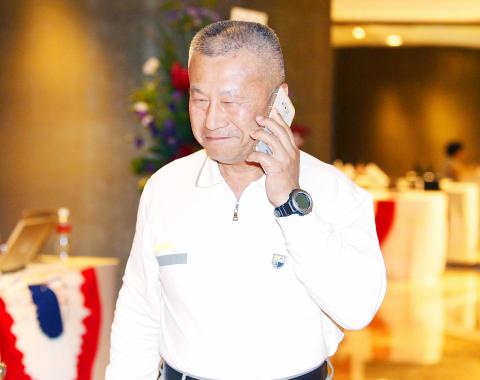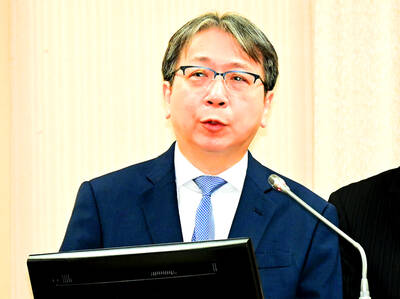The Ministry of National Defense yesterday expressed optimism after the US Senate Committee on Armed Services passed a provision that would re-establish regular visits by US Navy vessels to Kaohsiung or “other suitable ports” and allow the US Pacific Command to “receive ports of call by Taiwan.”
The committee on Thursday voted to allow the exchanges as part of next year’s National Defense Authorization Act, which is to be sent to the full Senate for consideration.
“The move shows that the US values military exchanges with Taiwan. The ministry welcomes any form of partnership that would enhance Taiwan’s national defense capabilities and bring stability to the region,” the ministry said in a statement.

Photo: CNA
Taiwan International Ports Corp (臺灣港務), which is in charge of operations at the nation’s seaports, said that the ministry has its own wharves at some ports.
Should military vessels from other nations need to make stops in Taiwan, they would have to contact the ministry for permission to dock at its wharves, the firm said, adding that military ships would not dock at wharves used by commercial vessels.
The ministry could request the company’s assistance if its wharves cannot accommodate larger warships, the firm added.
Keelung, Kaohsiung, Suao and Taichung ports have military facilities, the Maritime Ports Bureau said.
Bureau Deputy Director-General Lee Yun-wan (李雲萬), who was a student at National Taiwan Ocean University in Keelung when the US Navy’s Seventh Fleet would make ports of call there, said that he recalled seeing a small aircraft carrier enter Keelung Port, although the vessel did not dock.
Only Kaohsiung Port can accommodate large aircraft carriers, which could enter through the second port entrance, Lee said.
He added that Keelung, Kaohsiung, Suao and Taichung ports can accommodate 9,000-tonne guided missile destroyers, such as the USS Fitzgerald, which earlier this month was involved in a collision with the Philippine-flagged cargo container ship ACX Crystal in Tokyo Bay.

The US government has signed defense cooperation agreements with Japan and the Philippines to boost the deterrence capabilities of countries in the first island chain, a report by the National Security Bureau (NSB) showed. The main countries on the first island chain include the two nations and Taiwan. The bureau is to present the report at a meeting of the legislature’s Foreign Affairs and National Defense Committee tomorrow. The US military has deployed Typhon missile systems to Japan’s Yamaguchi Prefecture and Zambales province in the Philippines during their joint military exercises. It has also installed NMESIS anti-ship systems in Japan’s Okinawa

TRAGEDY STRIKES TAIPEI: The suspect died after falling off a building after he threw smoke grenades into Taipei Main Station and went on a killing spree in Zhongshan A 27-year-old suspect allegedly threw smoke grenades in Taipei Main Station and then proceeded to Zhongshan MRT Station in a random killing spree that resulted in the death of the suspect and two other civilians, and seven injured, including one in critical condition, as of press time last night. The suspect, identified as a man surnamed Chang Wen (張文), allegedly began the attack at Taipei Main Station, the Taipei Fire Department said, adding that it received a report at 5:24pm that smoke grenades had been thrown in the station. One man in his 50s was rushed to hospital after a cardiac arrest

ON ALERT: Taiwan’s partners would issue warnings if China attempted to use Interpol to target Taiwanese, and the global body has mechanisms to prevent it, an official said China has stationed two to four people specializing in Taiwan affairs at its embassies in several democratic countries to monitor and harass Taiwanese, actions that the host nations would not tolerate, National Security Bureau (NSB) Director-General Tsai Ming-yen (蔡明彥) said yesterday. Tsai made the comments at a meeting of the legislature’s Foreign Affairs and National Defense Committee, which asked him and Minister of National Defense Wellington Koo (顧立雄) to report on potential conflicts in the Taiwan Strait and military preparedness. Democratic Progressive Party (DPP) Legislator Michelle Lin (林楚茵) expressed concern that Beijing has posted personnel from China’s Taiwan Affairs Office to its

PUBLIC SAFETY: The premier said that security would be tightened in transport hubs, while President Lai commended the public for their bravery The government is to deploy more police, including rapid response units, in crowded public areas to ensure a swift response to any threats, President William Lai (賴清德) said yesterday after a knife attack killed three people and injured 11 in Taipei the previous day. Lai made the remarks following a briefing by the National Police Agency on the progress of the investigation, saying that the attack underscored the importance of cooperation in public security between the central and local governments. The attack unfolded in the early evening on Friday around Taipei Main Station’s M7 exit and later near the Taipei MRT’s Zhongshan